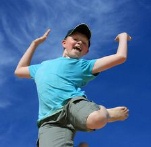Interventions Based on Physical Exercise and Autism
Introduction
 There are many interventions based around physical exercise. Some of those activities may be very energetic (such as trampolining) while others may be less energetic (such as tai chi).
There are many interventions based around physical exercise. Some of those activities may be very energetic (such as trampolining) while others may be less energetic (such as tai chi).
Specific interventions which include some form of physical exercise or activity include:
Standard health care practices in which exercise is a key component: Includes physiotherapy.
Sports-based activities which uses aerobic/strenuous exercise: Includes cycling and running.
Mind-body interventions: Includes martials arts such as karate and mind-body exercises such as yoga.
Creative and expressive arts therapies in which movement is a key component: Includes dance movement therapy.
Animal-assisted interventions and therapies in which movement may be a key component: Includes dolphin therapy, equine assisted interventions and therapies
Other interventions in which physical activity is a significant component: Includes daily life therapy, the Dore programme, the Miller method.
In this section, we concentrate on those interventions based on physical exercise which are not covered elsewhere on this website, specifically some sports-based interventions, some marital arts and and some approaches which use mind-body exercises.
Please note: Some of the exercises in this section fall into more than one of these categories. For exampl, tai chi is both a mind-body exercise and a martial art.
Evidence
Determining the benefits of interventions based on physical exercise for autistic people is difficult because it includes such a wide range of practices. We must wait for further research of sufficiently high quality to be completed
Risks and safety
Many interventions based on physical exercise , such as tai chi, appear to be relatively safe as they rely on slow, careful movements. However some interventions based on physical exercise, such as trampolining, may pose some risks to a small number of people:
Sports-based interventions
There is a wide range of sports-based interventions which are based on the principle of strenuous (aerobic) physical exercise, although it is of course possible to undertake that exercise in a less strenuous (non-aerobic) way.
All of the following sports-based exercise have been suggested as interventions for autistic people although, in most cases, there is very little if any research to support their use beyond the research that exists for non-autistic people.
Cycling, gym work, jogging, rebound therapy (trampolining), roller skating, running, swimming, weight training and related activities
More information
Please see
- publications on Physical Exercise
Martial Arts
Martial arts are codified systems and traditions of combat practices, which are practiced for a variety of reasons: self-defence, competition, physical health and fitness, entertainment, as well as mental, physical, and spiritual development.
Martial arts include aikido, boxing, judo, karate, kick boxing, kung fu, taekwondo and wrestling - although there are many, many others.
Both of the marital arts listed below have been suggested as interventions for autistic people.
- Karate is a martial art which uses a variety of striking techniques, including punching, kicking, knee and elbow strikes. The word karate is a combination of two kanji (Chinese characters): kara, meaning empty, and te,meaning hand; thus, karate means "empty hand."There are four main styles of karate including Shito-ryu, Goju-ryu, Shotokan-ryu, and Wado-ryu.
- Taekwondo is a Korean art of unarmed self-defence characterised by the extensive use of kicks. "Tae" means "foot" or "to strike with the feet". "Kwon" means "hand", or "to strike with the hand". "Do" means discipline, art, or way. Hence TaeKwonDo (foot-hand-way) means literally "the art of the feet and the hands" or "the art of kicking and punching".
More information
Please see
- publications on Martial Arts
Mind-Body Exercise
Mind-body exercises focus on the interactions between the brain, mind, body, and behaviour.
The idea behind mind-body exercises is that the mind and the body can be used to affect physical functioning and to promote health.
Mind-body exercises tend to be less vigorous than other forms of physical exercise and are used wiithin many approaches including:
- Nei yang gong is a mind-body intervention based upon the traditional Chinese Shaolin healing practice, Chanyi. Nei yang gong consists of a set of movements that emphasise smooth, gentle and calm movements, and the maintenance of a natural and relaxed attitude during practice. Nei yang gong is designed to foster self-awareness and mental self-control to help restore a calm and relaxed state, reducing stress, and increasing flexibility of the limbs.
- Qigong is a form of traditional Chinese mind-body exercise and meditation that uses slow and precise body movements with controlled breathing and mental focusing to improve balance, flexibility, muscle strength, and overall health. There are probably many different qigong styles, each with practical applications and different theories about Qi (“subtle breath” or “vital energy”) and Gong (“skill cultivated through steady practice”).
- Tai chi is a gentle exercise programme composed of slow, deliberate movements, meditation, and deep breathing, which enhance physical health and emotional well-being. The ultimate purpose of tai chi is cultivate the qi or life energy within us to flow smoothly and powerfully throughout the body. There are many styles and forms of tai chi, the major ones being Chen, Yang, Wu, and Sun.
- Yoga is a mind-body practice with origins in ancient Indian philosophy. The various styles of yoga that people use for health purposes typically combine physical postures, breathing techniques, and meditation or relaxation. There are numerous schools of yoga. Hatha yoga, the most commonly practiced in the United States and Europe, emphasises postures (asanas) and breathing exercises (pranayama). Some of the major styles of hatha yoga include Iyengar, Ashtanga, Vini, Kundalini, and Bikram yoga.
More information
Please see
- publications on Mind-Body Exercises
Related Pages
Related Glossaries
- Updated
- 27 May 2022

